Topic Question Set
Q 1
:
Which structure of protein remains intact after coagulation of egg white on boiling? [2024]
Primary
Tertiary
Secondary
Quaternary
(1)
During denaturation secondary and tertiary structures are destroyed but primary structure remains intact. For example: (a) the coagulation of egg white on boiling (b) curdling of milk which is caused due to the formation of lactic acid by the bacteria present in milk.
Q 2
:
Type of amino acids obtained by hydrolysis of proteins is: [2024]
(4)
Proteins are polymers of amino acids.
Q 3
:
Coagulation of egg, on heating is because of: [2024]
Biological property of protein remains unchanged
Denaturation of protein occurs
Breaking of the peptide linkage in the primary structure of protein occurs
The secondary structure of protein remains unchanged
(2)
The coagulation of egg white on boiling is an example of denaturation of protein. When a protein in its native form is subjected to physical change like change in temperature or chemical change like change in pH, the hydrogen bonds are disturbed. Due to this, globules unfold and helix get uncoiled and protein loses its biological activity. This is called denaturation of protein. During denaturation secondary and tertiary structures are destroyed but primary structure remains intact.
Q 4
:
The total number of carbon atoms present in tyrosine, an amino acid, is ______. [2024]
(9)
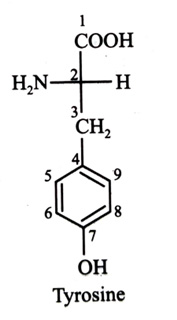
Q 5
:
Identify the correct statement among the following: [2025]
All naturally occurring amino acids except glycine contain one chiral centre.
All naturally occurring amino acids are optically active.
Glutamic acid is the only amino acid that contains a –COOH group at the side chain.
Amino acid, cysteine easily undergo dimerization due to the presence of free SH group.
(4)

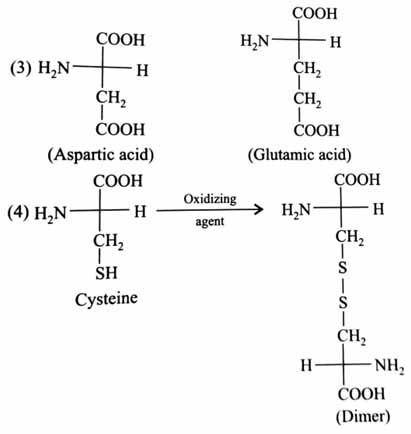
Q 6
:
A tetrapeptide “x” on complete hydrolysis produced glycine (Gly), alanine (Ala), valine (Val), leucine (Leu) in equimolar proportion each. The number of tetrapeptides (sequences) possible involving each of these amino acids is [2025]
16
32
8
24
(4)
Possible combinations = 4 × 3 × 2 × 1 = 24
Q 7
:
Identify the pair of reactants that upon reaction, with elimination of HCl will give rise to the dipeptide Gly–Ala. [2025]
(1)
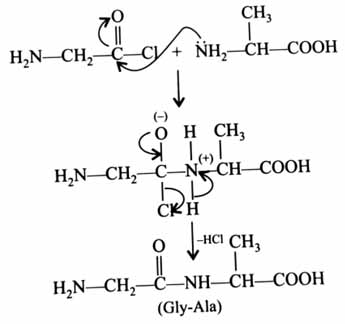
Q 8
:
A dipeptide, “x” on complete hydrolysis gives “y” and “z”. “y” on treatment with aq. produces lactic acid. On the other hand “z” on heating gives the following cyclic molecule.
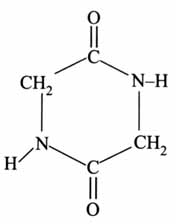
Based on the information given, the dipeptide X is: [2025]

valine–glycine
alanine–glycine
valine–leucine
alanine–alanine
(2)
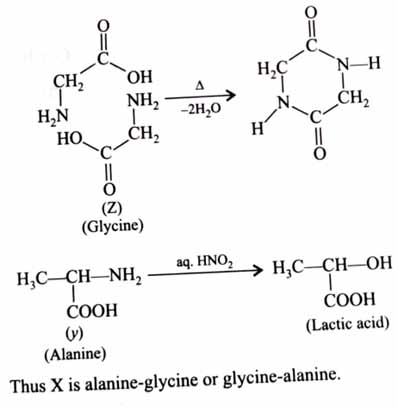
Q 9
:
Given below are two statements: [2025]
Statement (I): On hydrolysis, oligopeptides give rise to fewer number of -amino acids while proteins give rise to a large number of α-amino acids.
Statement (II): Natural proteins are denatured by acids which convert the water soluble form of fibrous proteins to their water insoluble form.
In the light of the above statements, choose the most appropriate answer from the options given below:
Both statement I and statement II are correct
Statement I is incorrect but Statement II is correct
Both statement I and statement II are incorrect
Statement I is correct but Statement II is incorrect
(3)
Statement I: Hydrolysis of proteins give amino acids.
Statement II: Protein found in a biological system with a unique three-dimensional structure and biological activity is called a native protein. When a protein in its native form is subjected to physical change like change in temperature or chemical change like change in pH, the hydrogen bonds are disturbed. Due to this, globules unfold and helix get uncoiled and protein loses its biological activity. This is called denaturation of protein. During denaturation secondary and tertiary structures are destroyed but primary structure remains intact.
Fibrous proteins are generally insoluble in water.
Q 10
:

Choose the correct option for structures of A and B, respectively. [2025]

(1)
In acidic medium (pH = 2) lone pair on N is donated to . In basic medium (pH = 10), of COOH is lost.









